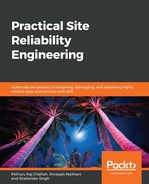Lately, microservices architecture (MSA) is gaining a lot of mind and market shares. Monolithic and massive applications are being continuously dismantled to be a pool of easily manageable and composable microservices. Application development and maintenance (ADM) service providers know the perpetual difficulties of building and sustaining legacy applications, which are closed, inflexible, and expensive. The low utilization and reuse are other drawbacks. Enabling them to be web, mobile, and cloud ready is beset with a number of practical challenges. Modernizing and migrating legacy applications to embrace newer technologies and to run them in optimized IT environments consumes a lot of time, talent, and treasure. Software development takes the agile route to bring forth business value in the shortest possible time. Software delivery and deployment are getting equally sped up through the DevOps concept, which is being facilitated through a host of powerful automation tools and techniques. Now, the software solution design also has to be accelerated in a risk-free fashion. Here comes the microservices architecture style and pattern.
Microservices is emerging as an excellent architecture style enabling the division of large and complex applications into micro-scaled yet many services. Each one runs in its own process and has its own APIs, and communicates with one another using lightweight mechanisms such as HTTP. Microservices are built around business capabilities, loosely coupled and highly cohesive, horizontally scalable, independently deployable, and technology-agnostic. Each microservice is supposed to do one task well. On the other hand, when these microservices get systematically composed, the realization of enterprise-scale and business-critical applications in which large complex software applications are composed from several services. It is quite easy to deploy newer versions of microservices frequently. That is, any kind of user recommendations, business sentiment changes, and technology updates can be deftly accommodated and delivered. Similarly, designing, developing, debugging, delivering, deploying, and decommissioning newer microservices can be swiftly done. There are enabling platforms and optimized IT infrastructures for the faster realization of microservices, which can be easily and quickly deployed.
Microservices are also innately facilitating horizontal scalability. Microservices are self-defined, autonomous, and decoupled. The dependency-imposed constrictions are elegantly eliminated, thereby faults are tolerated and the required isolation is being achieved. Microservices development teams can independently deliver on business requirements faster. However, there are some fresh operational challenges being associated with microservices-centric applications. Microservices ought to be dynamically discovered. On finding the network location addresses, the control and data flows have to be precisely routed to the correct and functioning microservices. There has to be a controlled and secured access to microservices, which need to be minutely monitored, measured, and managed to fulfil the designated business targets can be attained.
All kinds of logging and operational data have to be consciously and consistently collected, cleansed, and crunched to extricate usable and useful operational insights in time. Microservices are increasingly containerized, and powerful DevOps tools (continuous building, integration, testing, delivery, and deployment) are being used for business empowerment.
In spite of all those top claims, the microservices architecture is simply an evolutionary one. It inherits some of the baggage of the previous incarnation, which is nonetheless the service-oriented architecture (SOA) pattern. The enterprise service bus (ESB) is the service bus/gateway/broker/messaging middleware in the SOA world. ESB comes with service discovery, mediation, enrichment, resiliency, security, and other concierge-like capabilities. However, in the ensuing microservices era, the ESB-like monolithic software gets expressed and exposed as a dynamic set of interactive microservices. The beauty lies in segregating business capabilities from all kinds of support services. As illustrated in the following diagram, the networking/communication functionalities are separated out of the core activities of microservices. This segregation brings forth a number of business and technical advantages:

We have discussed the containerization phenomenon and the faster proliferation of microservices as the highly optimized application building block and the deployment unit. Now, there is a greater interest in converging these two strategically sound concepts. The combination is going to be disruptive, innovative, and transformative for business enterprises. The enterprise and cloud IT divisions are going to be the most constructive and contributive. The promising convergence of microservices and containerization is to open up hitherto unknown and unheard possibilities and fresh opportunities for business and IT domains.
